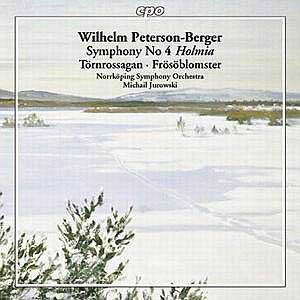Wilhelm Peterson-Berger was a minor Swedish symphonist.
Most of his output was song based and, as a songwriter, he is well known
throughout Scandinavia. He wrote five symphonies and these are being
systematically recorded for us by CPO and Swedish Radio.
The current disc, a recording of the 4th
Symphony, sub-titled "Holmia" was Peterson-Berger’s
penultimate symphony (the fifth would follow in a further four years).
Here on this CPO release it has just about as good a performance as
it could have, with the Nörrkoping orchestra under Michel Jurowski
supplying a bright, forthright performance, accurately phrased and played
in a splendid, alive recording.
The major problem I have experienced with this disc
is nothing to do with the performance, recording or presentation of
these works – they are all first rate. No, it is more to do with the
musical inspiration of the composer himself, which appears to me to
be on an extremely low level. It is not that I think I could do better,
far from it, but after having played the disc many times over the last
few weeks, I find that it has registered very little impact on me. This
is probably down to me, but I feel I must warn potential purchasers
that they might be similarly affected by the these works.
Having stated my reservations, I have nothing but praise
for CPO in making these less than well known symphonies available to
us to expand our knowledge of them. We would be much the poorer without
them.
Fans of early twentieth century conservative Scandinavian
symphonies will be well pleased with these recordings.
The Fourth Symphony is written in three relatively
short movements, the middle one doubling as a slow movement and scherzo
combined. All three movements are lightweight and tuneful, and played
with sensitivity by the performers. The scherzo (placed in the middle
of the slow movement) is quite pleasant, and gives the orchestra an
opportunity to display their collective virtuosity. There is not much
evidence of organic growth throughout the symphony, but if this does
not bother you you will enjoy this.
The disc is completed by two Suites for orchestra,
one early work (Frösöblömster) a work which describes
The Flowers of Froso. It was written as a solo for piano and
subsequently orchestrated in 1934. As a piano work, it ensured that
the young composer made a lasting impression on the musical establishment,
and in terms of lyricism, it is somewhat ahead of the symphony.
The disc is completed by (Tornrossagan), another
work written earlier (in 1903) as a ballet, and reorganised into an
orchestral suite in 1934. Again, much better than the symphony, mainly
because it suits the composer’s abilities better. The disc is almost
redeemed by these two orchestral works, and I enjoyed them much more
than the symphony.
As usual with these issues from CPO – superb documentation
– well done CPO.
John Phillips


![]() See
what else is on offer
See
what else is on offer 